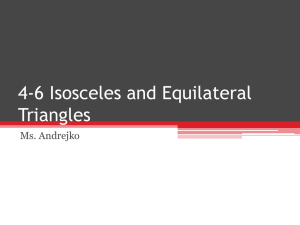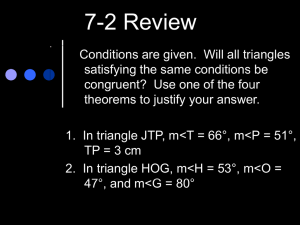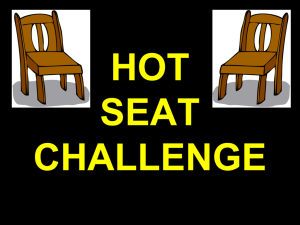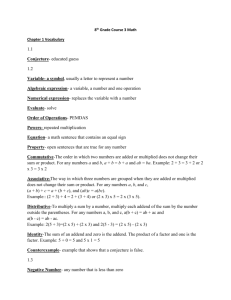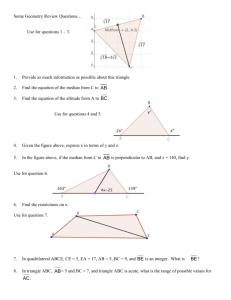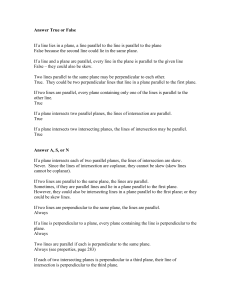100 Math Terms
advertisement
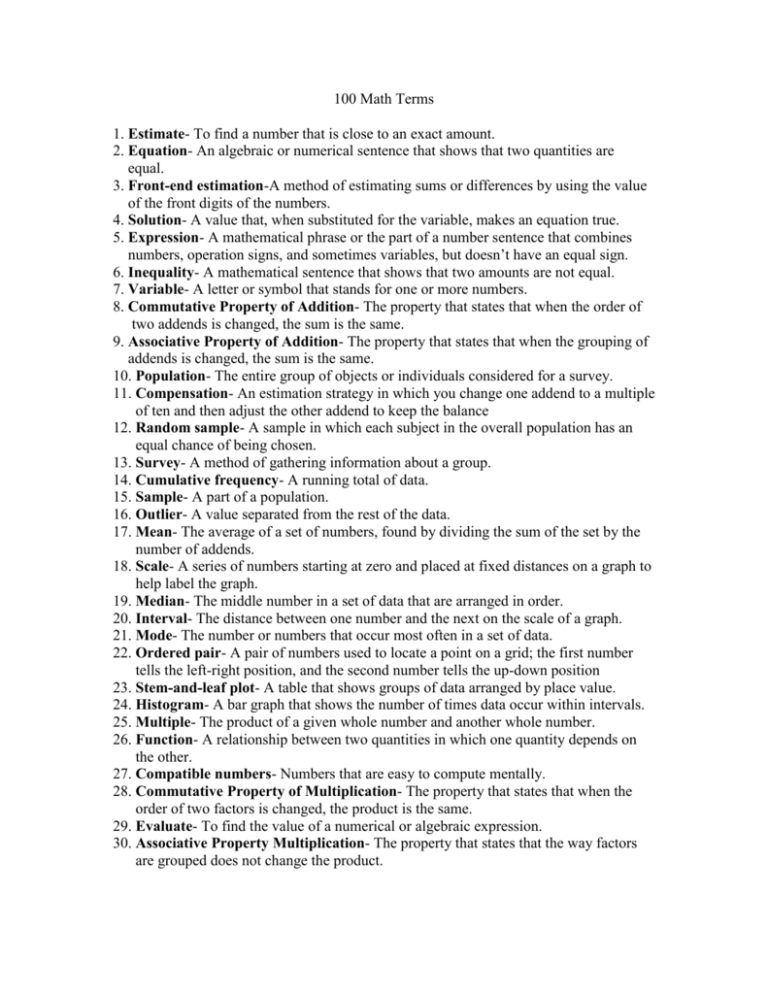
100 Math Terms 1. Estimate- To find a number that is close to an exact amount. 2. Equation- An algebraic or numerical sentence that shows that two quantities are equal. 3. Front-end estimation-A method of estimating sums or differences by using the value of the front digits of the numbers. 4. Solution- A value that, when substituted for the variable, makes an equation true. 5. Expression- A mathematical phrase or the part of a number sentence that combines numbers, operation signs, and sometimes variables, but doesn’t have an equal sign. 6. Inequality- A mathematical sentence that shows that two amounts are not equal. 7. Variable- A letter or symbol that stands for one or more numbers. 8. Commutative Property of Addition- The property that states that when the order of two addends is changed, the sum is the same. 9. Associative Property of Addition- The property that states that when the grouping of addends is changed, the sum is the same. 10. Population- The entire group of objects or individuals considered for a survey. 11. Compensation- An estimation strategy in which you change one addend to a multiple of ten and then adjust the other addend to keep the balance 12. Random sample- A sample in which each subject in the overall population has an equal chance of being chosen. 13. Survey- A method of gathering information about a group. 14. Cumulative frequency- A running total of data. 15. Sample- A part of a population. 16. Outlier- A value separated from the rest of the data. 17. Mean- The average of a set of numbers, found by dividing the sum of the set by the number of addends. 18. Scale- A series of numbers starting at zero and placed at fixed distances on a graph to help label the graph. 19. Median- The middle number in a set of data that are arranged in order. 20. Interval- The distance between one number and the next on the scale of a graph. 21. Mode- The number or numbers that occur most often in a set of data. 22. Ordered pair- A pair of numbers used to locate a point on a grid; the first number tells the left-right position, and the second number tells the up-down position 23. Stem-and-leaf plot- A table that shows groups of data arranged by place value. 24. Histogram- A bar graph that shows the number of times data occur within intervals. 25. Multiple- The product of a given whole number and another whole number. 26. Function- A relationship between two quantities in which one quantity depends on the other. 27. Compatible numbers- Numbers that are easy to compute mentally. 28. Commutative Property of Multiplication- The property that states that when the order of two factors is changed, the product is the same. 29. Evaluate- To find the value of a numerical or algebraic expression. 30. Associative Property Multiplication- The property that states that the way factors are grouped does not change the product. 31. Order of operations- Rules for performing operations in expressions with more than one operation; do the operations inside parentheses, then multiply and divide from left to right, then add and subtract from left to right 32. Distributive property- The property that states that multiplying a sum by a number is the same as multiplying each addend in the sum by the number and then adding the products. 33. Divisible- Capable of being divided without a remainder. 34. Exponent- A number that shows how many times the base is used as a factor. 35. Greatest common factor (GCF)- The greatest factor that two or more numbers have in common. 36. Base- A number used as a repeated factor. 37. Common multiple- A number that is a multiple of two or more numbers. 38. Square number- A product of a number and itself. 39. Least common multiple (LCM)- The least number, other than zero, that is a common multiple of two or more numbers. 40. Composite number- A whole number having more than two factors, such as 6, whose factors are 1, 2, 3, and 6. 41. Prime Number- A whole number that has exactly two factors: I and itself. 42. Simplest form- The form of a fraction in which the numerator and denominator have only I as a common factor. 43. Prime factorization- The process of factoring a composite number into its prime components, as with a factor tree, so that it is written as the product of all its prime factors. 44. Mixed number- A number that is made up of a whole number and a fraction. 45. Factor tree- A diagram that shows the prime factors of a number. 46. Least common denominator (LCD)- The least common multiple of two or more denominators. 47. Equivalent fractions- Fractions that name the same number or amount. 48. Reciprocal- One of two number whose product is I 8 x 1/8 = I 49. Point- An exact location in space, usually represented by a dot. 50. Plane- A flat surface that extends without end in all directions. 51. Line- A straight path in a plane, extending in both directions with no endpoints. 52. Angle- A figure formed by two rays that meet at a common endpoint. 53. Ray- A part of line; it begins at one endpoint and extends forever in one direction. 54. Parallel lines- Lines in a plane that do not intersect. 55. Line segment- A part of a line between two endpoints. 56. Intersecting lines- Lines that cross each other at exactly one point. 57. Perpendicular lines- Two lines that intersect to form right angles. 58. Regular polygon- A polygon in which all sides are congruent and all angles are congruent. 59. Degree- A unit for measuring angles or temperature. 60. Circle- A closed figure with all points on the figure the same distance from the center point. 61. Protractor- A tool used for measuring or drawing angles. 62. Radius- A line segment with one endpoint at the center of a circle and the other endpoint on the circle. 63. Polygon- a closed plane figure formed by three or more line segments. 64. Diameter- A line segment that passes through the center of a circle and has its endpoints on the circle. 65. Chord- A line segment with endpoints on a circle. 66. Similar- Having the same shape but not necessarily the same size. 67. Compass- A tool used to construct circles and arcs. 68. Corresponding angles - Angles that are in the same position in different plane figures. 69. Central angle- An angle formed by two radii of a circle that meet at its center. 70. Corresponding sides- Sides that are in the same position in different plane figures. 71. Congruent- Having the same size and shape. 72. Line symmetry- The property of a figure that can be separated by a line into two congruent parts. 73. Rotational symmetry- The property of a figure that, when rotated less than 360 degrees about a central point or a point of rotation, still matches the original figure. 74. Leg- In a right triangle, either of two sides that form the right angle. 75. Isosceles triangle- A triangle with exactly two congruent sides. 76. Hypotenuse- In a right triangle, the side opposite the right angle; the longest side in a right triangle. 77. Scalene triangle- A triangle with no congruent sides. 78. Figurate numbers- Numbers that can be represented by geometric figures. 79. Equilateral triangle- A triangle with three congruent sides. 80. Triangular numbers- Numbers that can be represented by triangular figures. 81. Trapezoid- A quadrilateral with exactly one pair of parallel sides. 82. Reflection- A movement of a figure to a new position by flipping it over a line; a flip. 83. Rhombus- a parallelogram with congruent sides. 84. Rotation- A movement of a figure to a new position by turning it around a fixed point; a turn. 85. Parallelogram- A quadrilateral whose opposite sides are parallel and congruent. 86. Transformation- The movement of a figure to a new position by a translation, reflection, or rotation. 87. Translation- A movement of a figure to a new position along a straight line; a slide. 88. Tessellation- A repeating pattern of closed figures that covers a surface with no gaps and no overlaps. 89. Polyhedron- A solid figure with faces that are polygons. 90. Integers- The set of whole numbers and their opposites. 91. Pyramid- A solid figure with a polygon base and all other faces are triangles that meet at a common vertex. 92. Negative integer- Any integer less than zero. 93. Prism- A solid figure that has two congruent, polygon-shaped bases and whose other faces are all rectangles. 94. Positive integer- Any integer greater than zero. 95. Base- A polygon’s side or a solid figure’s face by which the figure is measured or named. 96. Opposites- Two numbers that are the same distance, but in opposite directions, from zero on a number line. 97. Absolute value- The distance of a number from zero on a number line. 98. Origin- The point where two axes of a coordinate plane intersects, (0,0). 99. X-axis- The horizontal number line on a coordinate plane. 90. Coordinates- The numbers in a ordered pair. 91. Y-axis- The vertical number line on a coordinate plane. 92. Precision- A property of measurement that is related to the unit of measure used; the smaller the unit of measure used, the more precise the measurement. 93. Coordinate plane- A plane formed by two intersecting and perpendicular number lines called axes. 94. Millimeter (mm)- A metric unit for measuring length or distance; millimeter = 0.001 meter 95. Centimeter (cm)- A metric unit for measuring length or distance; 1 centimeter = 0.01 meter. 96. Meter (m)- A metric unit for measuring length or distance; 1 meter = 100 centimeters 97. Perimeter- The distance around a closed plane figure. 98. Kilometer (km)- A metric unit for measuring length or distance; 1 kilometer = 1000 meters 99. Circumference- The distance around a circle. 100. Area- The number of square units needed to cover a surface.


